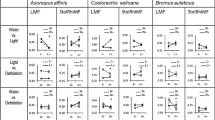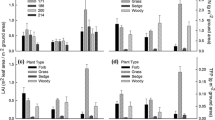Summary
Agropyron desertorum, a grazing-tolerant bunchgrass introduced to the western U.S. from Eurasia, and Agropyron spicatum, a grazing-sensitive bunchgrass native to North America, were examined in the field for photosynthetic capacity, growth, resource allocation, and tiller dynamics. These observations allowed identification of physiological characteristics that may contribute to grazing tolerance in semiarid environments. A uniform matrix of sagebrush, Artemisia tridentata, provided an ecologically relevant competitive environment for both bunch-grass species. Physiological activity, growth, and allocation were also followed during recovery from a severe defoliation treatment and were correlated with tiller dynamics.
Potential photosynthetic carbon uptake of both species was dominated by stems and leaf sheaths during June, when maximum uptake rates occurred. For both species, water use efficiency of stems and sheaths was similar to that of leaf blades, but nitrogen investment per photosynthetic surface area was less than in blades. In addition, soluble carbohydrates in stems and sheaths of both species constituted the major labile carbon pools in control plants. Contrary to current theory, these findings suggest that culms from which leaf blades have been removed should be of considerable value to defoliated bunchgrasses, and in the case of partial defoliation could provide important supplies of organic nutrients for regrowth. These interpretations, based on total pool sizes, differ markedly from previous interpretations based on carbohydrate concentrations alone, which suggested that crowns contain large carbohydrate reserves. In this study, crowns of both species contained a minor component of the total plant carbohydrate pool.
Following defoliation, A. desertorum plants rapidly reestablished a canopy with 3 to 5 times the photosynthetic surface of A. spicatum plants. This difference was primarily due to the greater number of quickly growing new tillers produced following defoliation. Agropyron spicatum produced few new tillers following defoliation despite adequate moisture, and carbohydrate pools that were equivalent to those in A. desertorum.
Leaf blades of regrowing tillers had higher photosynthetic capacity than blades on unclipped plants of both species, but the relative increase, considered on a unit mass, area, or nitrogen basis, was greater for A. desertorum than for A. spicatum. Agropyron desertorum also had lower investment of nitrogen and biomass per unit area of photosynthetic tissues, more tillers and leaves per bunch, and shorter lived stems, all of which can contribute to greater tolerance of partial defoliation.
Greater flexibility of resource allocation following defoliation was demonstrated by A. desertorum for both nitrogen and carbohydrates. Relatively more allocation to the shoot system and curtailed root growth in A. desertorum resulted in more rapid approach to the preclipping balance between the root and shoot systems, whereas root growth in A. spicatum continued unabated following defoliation. Nitrogen required for regrowth in both species was apparently supplied by uptake rather than reserve depletion. Carbohydrate pools in the shoot system of both species remained very low following severe defoliation and were approximately equivalent to carbon fixed in one day by photosynthesis of the whole canopy.
Similar content being viewed by others
References
Archer S, Tieszen L (1980) Growth and physiological responses of tundra plants to defoliation. Arctic Alpine Res 12:531–552
Baker HG (1978) Invasion and replacement in Californian and neotropical grasslands. In: JR Wilson (ed) Plant relations in pastures. Commonwealth Scientific and Industrial Research Organization East Melbourne p 368–384
Bingham GE, Coyne PI (1977) A portable, temperature-controlled, steady-state porometer for field measurements of transpiration and photosynthesis. Photosynthetica 11:148–160
Blaisdell JP, Pechanec JF (1949) Effects of herbage removal at various dates on vigor of bluebunch wheatgrass and arrowleaf balsamroot. Ecology 30:298–305
Bolton JK, Brown RH (1980) Photosynthesis of grass species differing in carbon dioxide fixation pathways. V. Response of Panicum maximum, Panicum milioides, and tall fescue (Festuca arundinacea) to nitrogen. Plant Physiol 66:97–100
Branson F (1953) Two new factors affecting resistance of grasses to grazing. J Range Manage 6:165–171
Cates RG, Orians GH (1975) Successional status and the palatability of plants to generalized herbivores. Ecology 56:410–418
Chapin F (1980) Nutrient allocation and responses to defoliation in tundra plants. Arctic Alpine Res 12:553–563
Christensen E (1963) The foothill bunchgrass vegetation of central Utah. Ecology 44:156–158
Cook C, Stoddart L (1953) Some growth responses of crested wheat-grass following herbage removal. J Range Manage 6:267–270
Cook C, Stoddart L, Kinsinger F (1958) Responses of crested wheat-grass to various clipping treatments. Ecol Monogr 28:237–272
Crider F (1955) Root-growth stoppage resulting from defoliation of grass. USDA Tech Bull No 1102
Cronquist A (1978) The biota of the Intermountain region in geohistorical context. In: SL Wood (ed) Great Basin Naturalist Memoirs No 2, Intermountain biogeography: A symposium. Brigham Young University Printing Service Provo p 3–5
Dahl B, Hyder D (1977) Developmental morphology and management implications. In: R Sosebee (ed) Rangeland plant physiology. Soc Range Manage Denver p 257–290
Daubenmire R (1940) Plant succession due to overgrazing in the Agropyron bunchgrass prairie of southeastern Washington. Ecology 21:55–64
Daubenmire R (1975) Plant succession on abandoned fields, and fire influences, in a steppe area in southeastern Washington. Northwest Sci 49:36–48
Dillman A (1946) The beginnings of crested wheatgrass in North America. J Amer Soc Agron 28:237–250
Dubois M, Gilles KA, Hamilton JK, Rebers PA, Smith F (1956) Colorimetric method for determination of sugars and related substances. Anal Chem 28:350–356
Frenzel B (1968) The Pleistocene vegetation of northern Eurasia. Science 161:637–649
Haissig BE, Dickson RE (1979) Starch measurement in plant tissue using enzymatic hydrolysis. Physiol Plant 47:151–157
Hoffmann RS (1974) Terrestrial vertebrates. In: JD Ives, RG Barry (eds) Arctic and alpine environments. Methuen and Co. London p 475–568
Hull AC, Klomp GJ (1974) Yield of crested wheatgrass under four densities of big sagebrush in southern Idaho. USDA Agr Res Ser Tech Bull No 1483
Hyder D (1972) Defoliation in relation to vegetative growth. In: V Younger, C McKell (eds) Biology and utilization of grasses. Academic Press New York p 304–317
Hyder D (1974) Morphogenesis and management of perennial grasses in the United States. In: Plant morphogenesis as the basis for scientific management of range resources. USDA Misc Pub No 1271 p 89–98
Hyder D, Sneva F (1963) Studies of six grasses seeded on sagebrushbunchgrass range. USDA Tech Bull 71
James D, Jurinak J (1978) Nitrogen fertilization of dominant plants in the notheastern Great Basin desert. In: N West, J Skujins (ed) Nitrogen in desert ecosystems. Dowden, Hutchinson and Ross, Inc. Stroudsburg p 219–231
Jameson DA (1963) Responses of individual plants to harvesting. Bot Rev 29:532–594
Janzen D (1969) Coevolution. Science 165:415
Janzen D, Juster H, Liener I (1976) Insecticidal action of the phytohemagglutinin in black beans on a bruchid beetle. Science 192:795–796
Klotzli F (1977) Wild und Vieh im Gebirgsgrassland Aethiopiens. In: R Tuxen (ed) Vegetation and fauna. J Cramer Vaduz p 479–512
Koch W, Lange OL, Schulze ED (1971) Ecophysiological investigations on wild and cultivated plants in the Negev Desert. I. Methods: A mobile laboratory for measuring carbon dioxide and water vapor exchange. Oecologia (Berl) 8:296–309
Kowalski K (1967) The Pleistocene extinction of mammals in Europe. In: PS Martin, HE Wright Jr (eds) Pleistocene extinctions: The search for a dause. Yale Univ Press New Haven p 349–364
Kurten B (1968) Pleistocene mammals of Europe. Aldine Publishing Co Chicago
Laycock WA (1967) How heavy grazing and protection affect sagebrush-grass ranges. J Range Manage 20:206–213
Leafe E (1972) Micro-environment, carbon dioxide exchange and growth in grass swards. In: A Rees, K Cockshull, D Hand, R Hurd (eds) Crop processes in controlled environments. Academic Press London p 157–174
Mark A (1969) Ecology of snow tussocks in the mountain grasslands of New Zealand. Vegetatio 18:289–306
McIlvanie S (1942) Carbohydrate and nitrogen trends in bluebunch wheatgrass, Agropyron spicatum, with special reference to grazing influences. Plant Physiol 17:540–557
Mueggler WF (1972) Influence of competition on the response of bluebunch wheatgrass to clipping. J Range Manage 25:88–92
Rosenthal GA (1977) Nitrogen allocation for L-canavanine synthesis and its relationship to chemical defense of the seed. Biochem Sys Ecol 5:219–220
Sneva F, Rittenhouse L (1976) Crested wheat production: Impacts on fertility, row spacing, and stand age. Oregon Agr Exp Sta Tech Bull 135
Southard A, Wilson L, Erickson A (1978) Chemical and physical properties of the soils of the Cache Valley area and eastern portion of Box Elder County, Utah. Utah Agr Exp Sta Res Rep 31
Stiles FG (1977) Coadapted competitors: the flowering seasons of hummingbird-pollinated plants in a tropical forest. Science 198:1177–1178
Stoddart LA (1946) Some physical and chemical responses of Agropyron spicatum to herbage removal at various seasons. Utah Agr Exp Sta Bull 324
Stoddart LA, Smith AD, Box TW (1975) Range Management. McGraw-Hill New York
Turner NC, Long MJ (1980) Errors arising from rapid water loss in the measurement of leaf water potential by the pressure chamber technique. Aust J Plant Physiol 7:527–537
Vereshchagin NK (1967) Primitive hunters and Pleistocene extinction in the Soviet Union. In: PS Martin, HE Wright Jr (eds) Pleistocene extinctions: The search for a cause. Yale Univ Press New Haven p 365–398
Walter H, Lieth H (1960) Klimadiagramm-Weltatlas. Gustav Fischer Jena
Ward KJ, Klepper B, Rickman RW, Allmaras RR (1978) Quantitative estimation of living wheat-root lengths in soil cores. Agron J 70:675–677
Waring RH, Cleary BD (1967) Plant moisture stress: evaluation by pressure bomb. Science 155:1248–1254
Warren Wilson J (1960) Inclined point quadrats. New Phytol 59:1–8
White LM (1973) Carbohydrate reserves of grasses: A review. J Range Manage 26:13–18
Willms W, Bailey AW, McLean A (1980) Effect of burning or clipping Agropyron spicatum in the autumn on the spring foraging behavior of mule deer and cattle. J Appl Ecol 17:69–84
Young VA (1943) Changes in vegetation and soil of Palouse prairie caused by overgrazing J For 41:834–838
Author information
Authors and Affiliations
Additional information
Dedicated to Drs. Michael Evenari and Konrad Springer
Rights and permissions
About this article
Cite this article
Caldwell, M.M., Richards, J.H., Johnson, D.A. et al. Coping with herbivory: Photosynthetic capacity and resource allocation in two semiarid Agropyron bunchgrasses. Oecologia 50, 14–24 (1981). https://doi.org/10.1007/BF00378790
Received:
Issue Date:
DOI: https://doi.org/10.1007/BF00378790




